Managing a large garden can feel overwhelming, but it’s also incredibly rewarding.
With the right strategies in place, you can keep your garden flourishing without spending all your free time working in it.
I’ve gathered some enjoyable and practical tips that simplify the care of a spacious garden, making the experience both manageable and enjoyable.
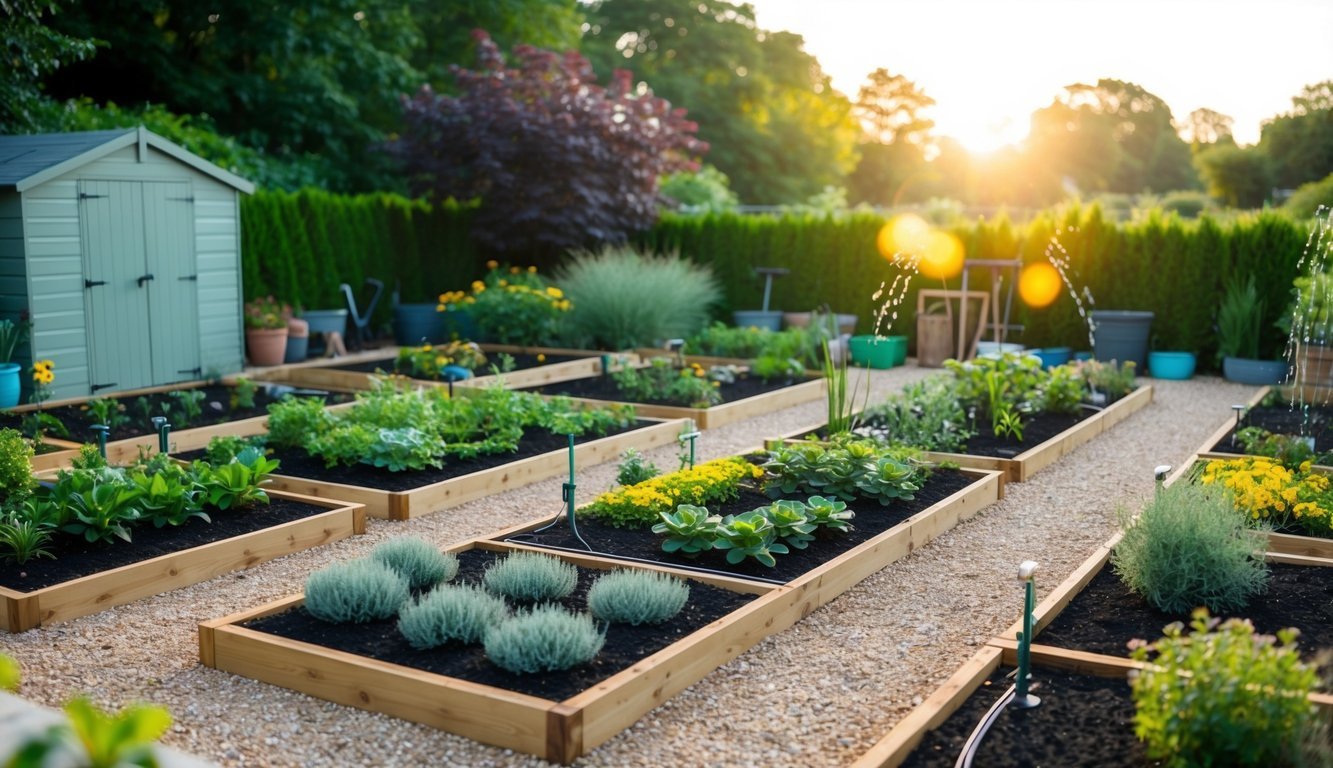
From choosing the right plants to creating efficient workflows, each tip can help me spend less time on chores and more time enjoying my outdoor space.
Whether I’m a seasoned gardener or just starting out, these insights will assist in transforming my large plot into a vibrant retreat, tailored to my lifestyle.
Raised Beds
I find raised beds to be a fantastic way to manage a large garden.
They keep my plants neat and organized, making it easier to tend to them.
Building a raised bed involves creating a frame using materials like wood, stone, or concrete.
Once that’s done, I fill it with quality soil.
This setup improves drainage and keeps pests at bay.
Raised beds warm up quicker in the spring, which helps me get a jump start on growing.
They also allow me to control soil quality more effectively.
Regularly adding compost keeps the nutrients up and promotes healthy growth.
Positioning raised beds in full sun is essential for most plants.
For edibles, like tomatoes or peppers, I ensure they get at least six to eight hours of sunlight each day.
Some plants thrive in partial shade, so I mix them in as needed.
Using raised beds not only organizes my garden but also minimizes bending and stretching, making gardening a lot easier on my back.
Plus, they add a nice aesthetic to my backyard.
Companion Planting
I’ve found that companion planting is a game changer for managing my garden.
It’s all about pairing plants that help each other grow.
For instance, combining corn, beans, and squash, known as “the three sisters,” creates a balanced environment.
Corn provides a strong structure for beans to climb.
Beans, in return, enrich the soil with nitrogen, while squash leaves provide shade, keeping moisture in and weeds down.
I also love using herbs like basil and marigolds alongside my vegetables.
They deter pests and attract beneficial insects, which helps keep my plants healthy.
It’s important to avoid certain combinations too.
For example, I steer clear of planting sage near cucumbers, as it can hinder their growth.
By being mindful of plant pairings, I maximize my garden’s potential.
This method not only saves space but also reduces the need for chemical fertilizers.
With companion planting, my garden feels more balanced and alive.
Mulching Magic
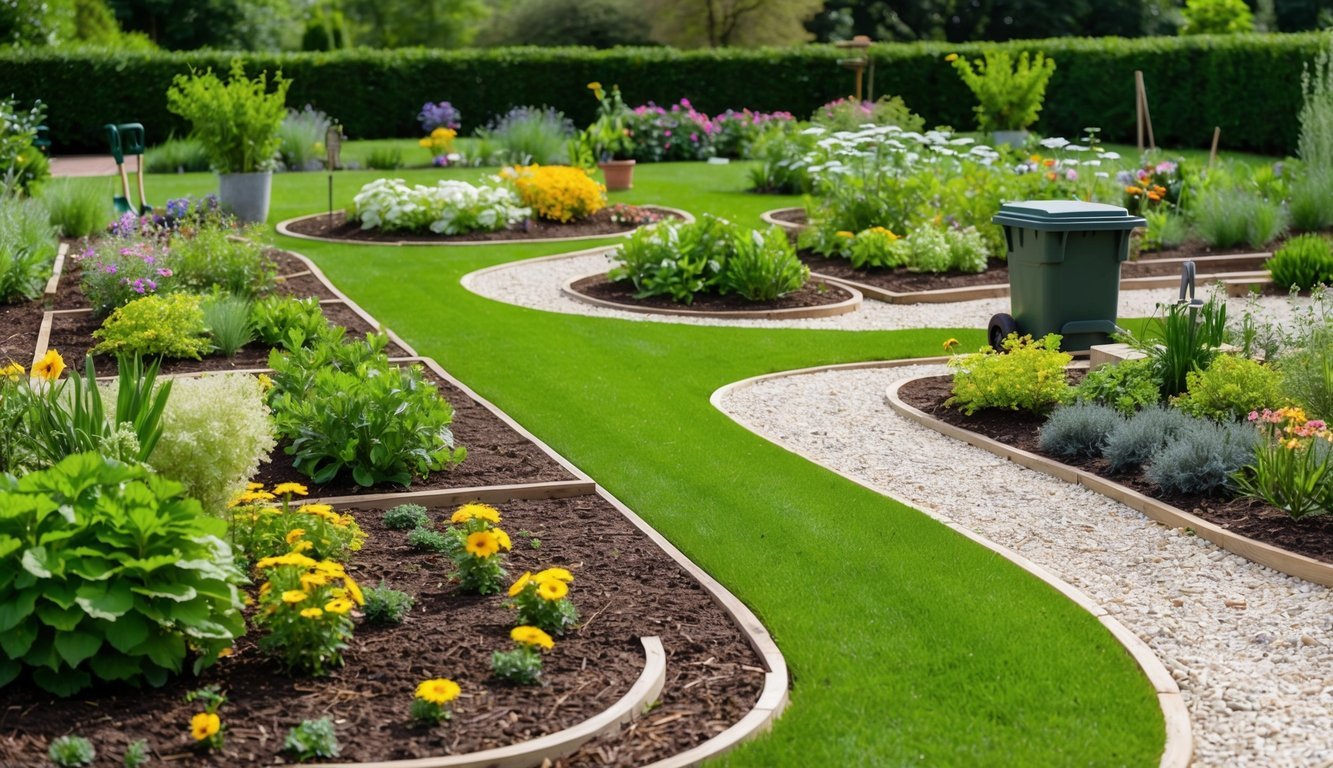
Mulching has transformed my gardening experience.
It’s a simple yet effective way to care for my plants while keeping things tidy.
I apply mulch in early spring and again in the fall.
This timing helps suppress weeds and retains moisture in the soil as temperatures change.
Plus, it gives my garden a polished look.
I like to experiment with different types of mulch.
Shredded leaves, straw, and pine needles are all great organic options.
Each type adds unique benefits to the garden, whether it’s moisture retention or nutrient addition.
When using mulch, I spread it about 2-3 inches thick.
This helps protect my plants and keeps the soil temperature consistent.
It’s also an excellent way to prevent damage from garden tools.
Mulching isn’t just practical; it adds a touch of charm to my garden space.
It feels like I’m creating a little oasis, one layer at a time.
Compost Corner
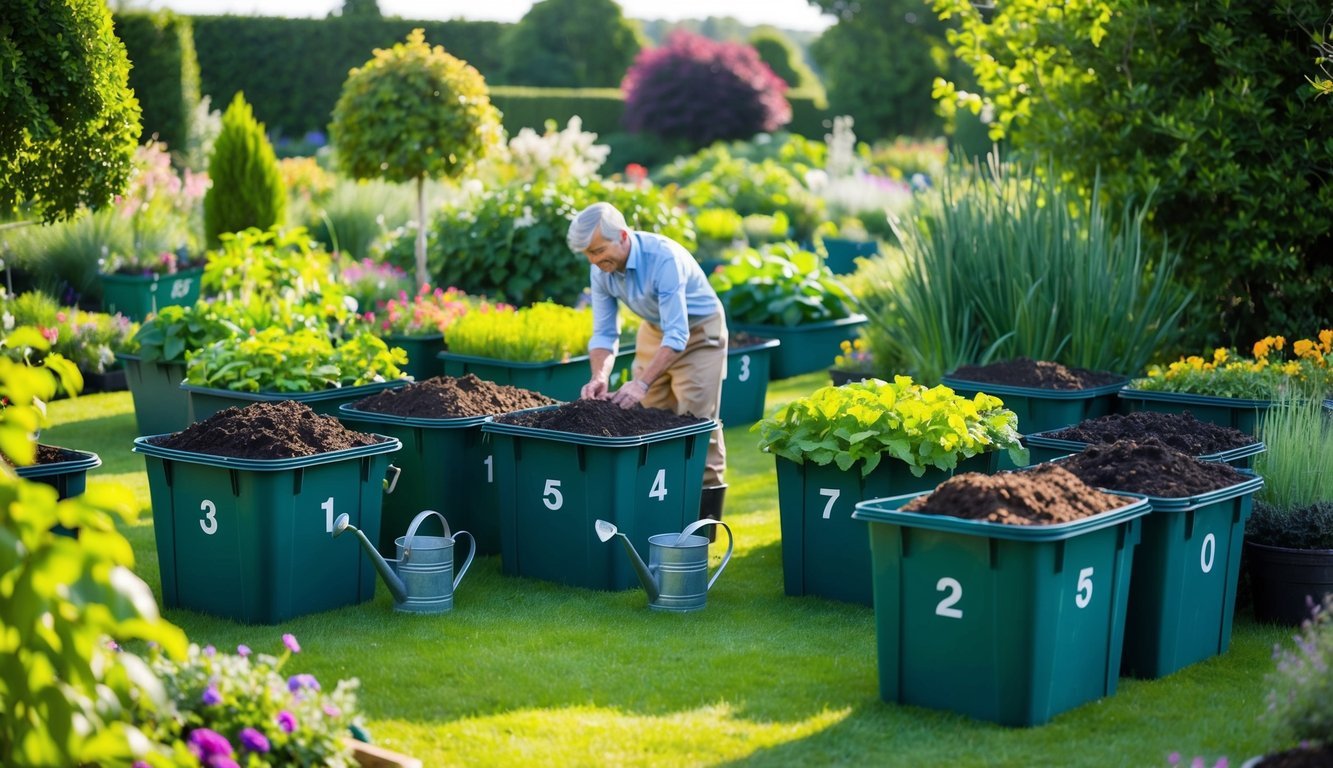
In my garden, composting has made a world of difference.
It’s a simple way to recycle kitchen scraps and yard waste, turning them into rich soil for my plants.
I’ve found that keeping a balance between nitrogen-rich greens and carbon-heavy browns speeds up the process.
Using a mix of leaves, grass clippings, and kitchen waste works best.
One method I enjoy is windrow composting.
It allows me to create long piles that stay aerated, speeding up decomposition.
For large spaces, this can be quite effective.
A compost tumbler is another handy tool.
It makes turning the pile easy and helps keep everything mixed well.
I appreciate having compartments for different stages of composting.
Regularly adding small amounts to my wormery also keeps it thriving.
Feeding the worms little by little really works to enhance the process.
By creating a designated compost corner, I keep my garden organized.
It turns waste into a valuable resource, simplifying my gardening routine.
5) Rain Barrels
Using rain barrels has been a game changer for my garden.
They’re a simple way to collect and store rainwater, which is great for conservation.
Most rain barrels hold about 50 to 55 gallons, which is plenty for my watering needs.
I love how I can easily access that water during dry spells without relying on the hose.
Setting them up is straightforward.
I drilled a hole near the bottom of a large plastic container and attached a spigot.
It’s handy to have an overflow outlet too, especially during heavy rains.
Choosing a barrel that fits my garden’s style was important.
Some barrels even have decorative designs that enhance my landscape while being functional.
I always make sure my stand is sturdy.
A full 55-gallon barrel weighs over 450 pounds, so I don’t want it tipping over.
With just a little maintenance, my rain barrel system keeps my plants happy and my water bill down.
6) Vertical Gardening
I’ve found vertical gardening to be a game-changer for managing my large garden.
It’s a smart way to save space while still growing a variety of plants.
By using walls, trellises, or fences, I can make the most of my gardening area.
One of my favorite setups is a living wall.
I secure a trellis panel and attach pots filled with herbs and vegetables.
This not only looks great but also keeps my plants healthy, as they’re less prone to rot and pests.
Water conservation is another perk.
Vertical gardens require less water than traditional setups because they reduce evaporation.
Plus, the plants create some shade for one another.
I also support my climbing plants with stakes or clips.
This helps them grow upward and stay sturdy, especially in windy conditions.
Overall, vertical gardening has definitely added more enthusiasm to my gardening routine.
7) Garden Journal
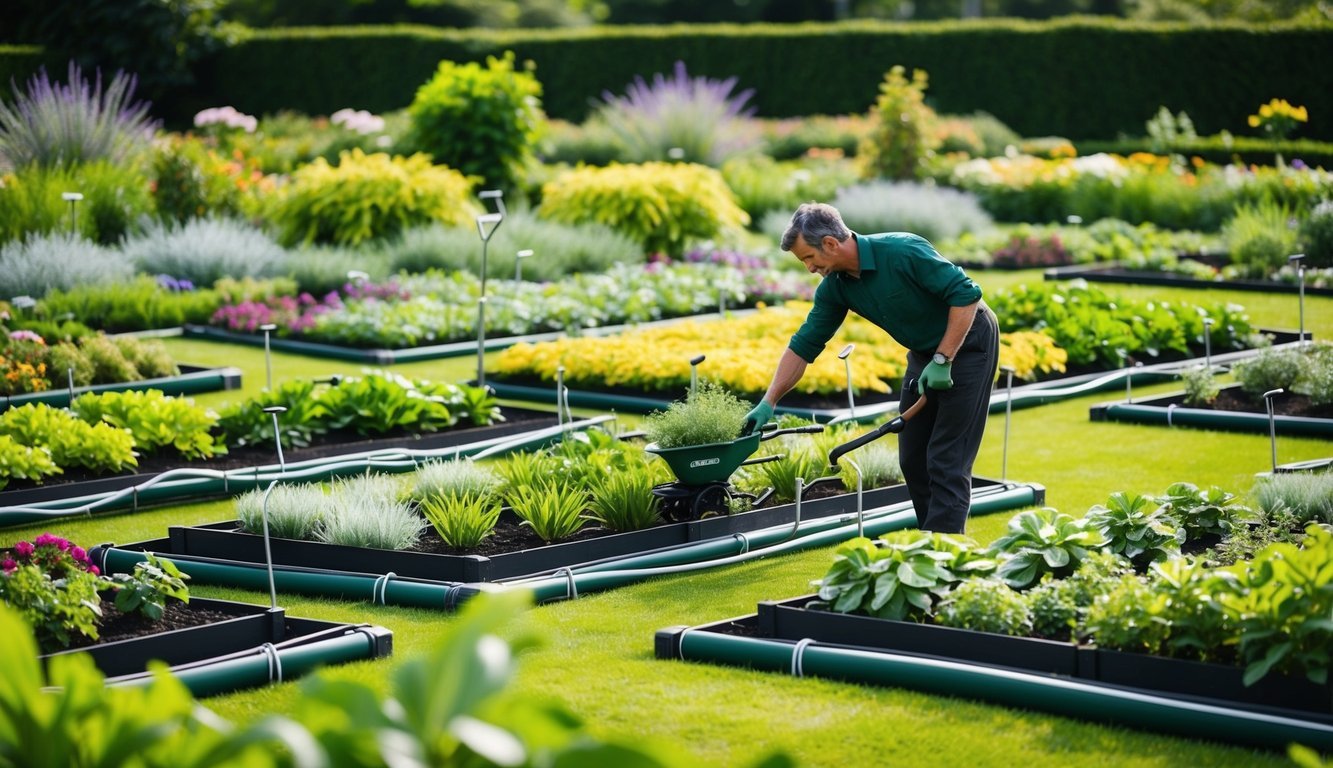
Keeping a garden journal has been a game changer for me.
It’s my go-to tool for tracking what I’ve planted and monitoring how things are growing.
Every time I plant a new seed or transfer a seedling, I jot it down.
This helps me remember what thrives in my garden and what doesn’t.
I also like to note down the weather and any pest issues.
That way, I can see patterns over time and adjust my care techniques.
Finding a journal that suits my style has been key.
I typically go for something simple, where I can easily write notes.
I often keep photos of my plants alongside my written observations.
It’s fun to flip through the pages and see how much my garden has changed!
8) Perennial Powerhouses
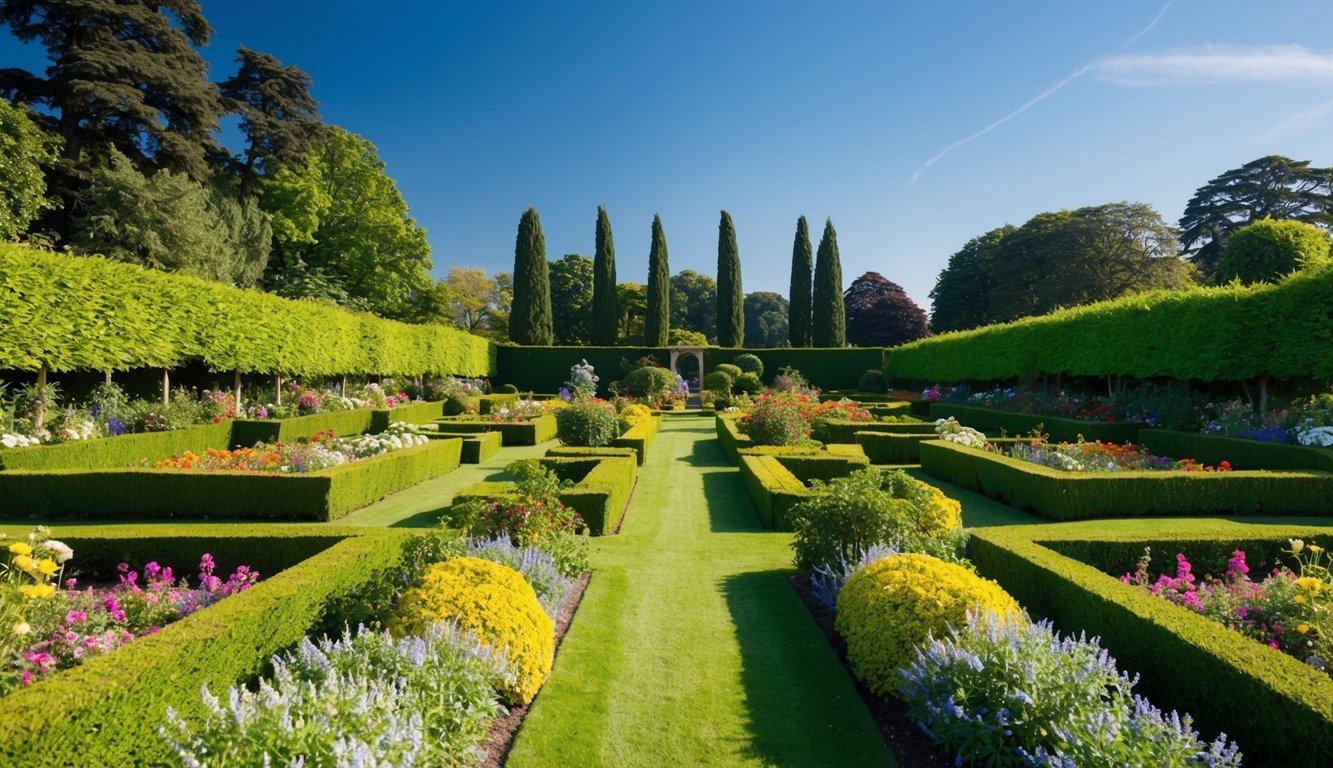
When managing a large garden, perennials are my go-to plants.
They come back year after year, which means less hassle for me.
I love choosing heat and drought-resistant varieties.
These plants thrive in extreme weather, offering resilience that minimizes my maintenance efforts.
Mixing different heights and colors adds visual interest.
I often repeat certain varieties throughout my garden for a cohesive look.
Compact perennials work well in containers, providing added versatility.
I can move them around as needed, adapting my garden’s layout effortlessly.
These powerhouses typically require less frequent watering and fertilizing.
This allows me to enjoy my garden without constant upkeep.
By planting smart and selecting reliable perennials, I can create a beautiful space that doesn’t demand all my time and energy.
9) Succession Planting
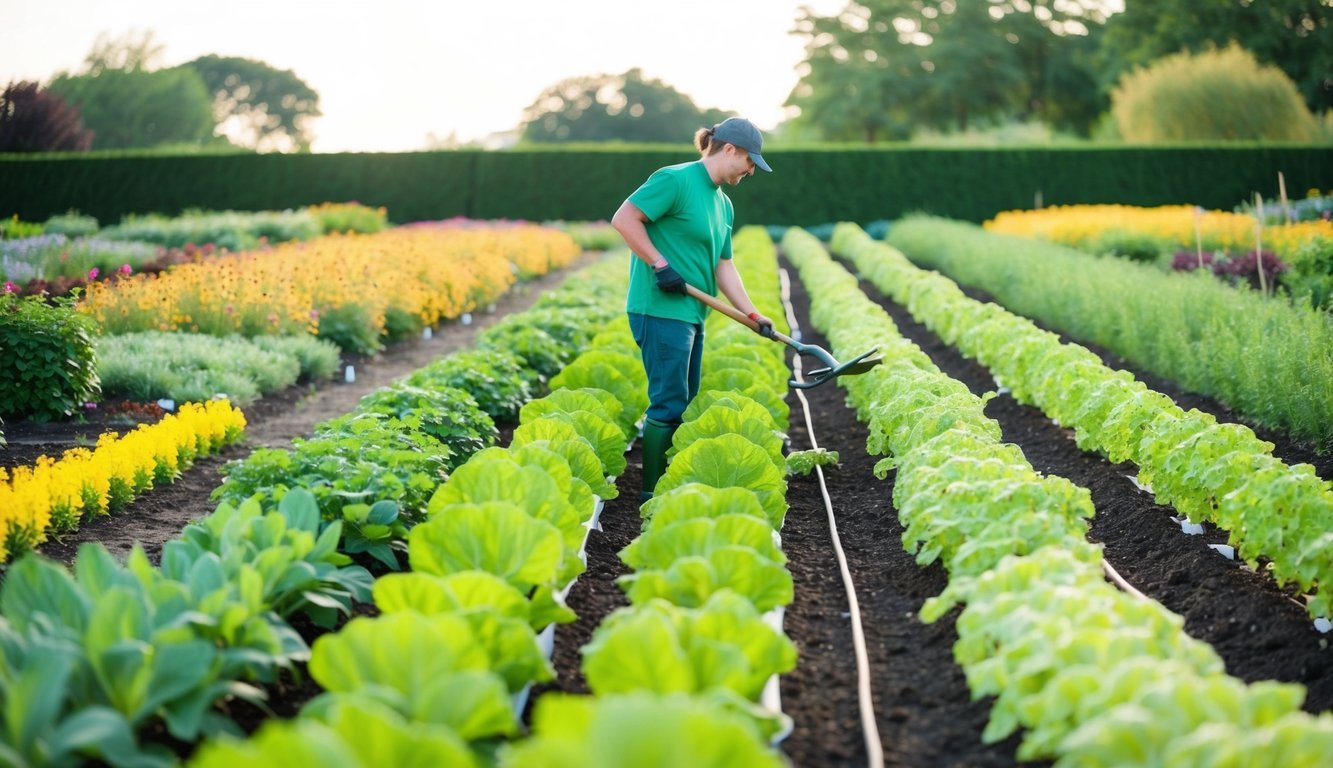
Succession planting is one of my favorite techniques for keeping my garden productive.
It means planting crops in intervals to ensure a steady supply of fresh produce throughout the growing season.
For example, I’ll plant a batch of lettuce, then wait a week or two before sowing another batch.
This way, I can enjoy fresh greens for a longer period.
Timing is key.
I find that planting carrots every few weeks ensures I have a continuous harvest.
Covering them with a row cover helps with moisture until they sprout.
In summer, I often plant bush beans every 14 days.
This provides me with a nice variety during peak harvest times.
Some crops, like tomatoes and potatoes, can be planted a few weeks apart for staggered harvesting.
The idea is to keep your garden full and your kitchen stocked as the growing season progresses.
10) Pest Patrol
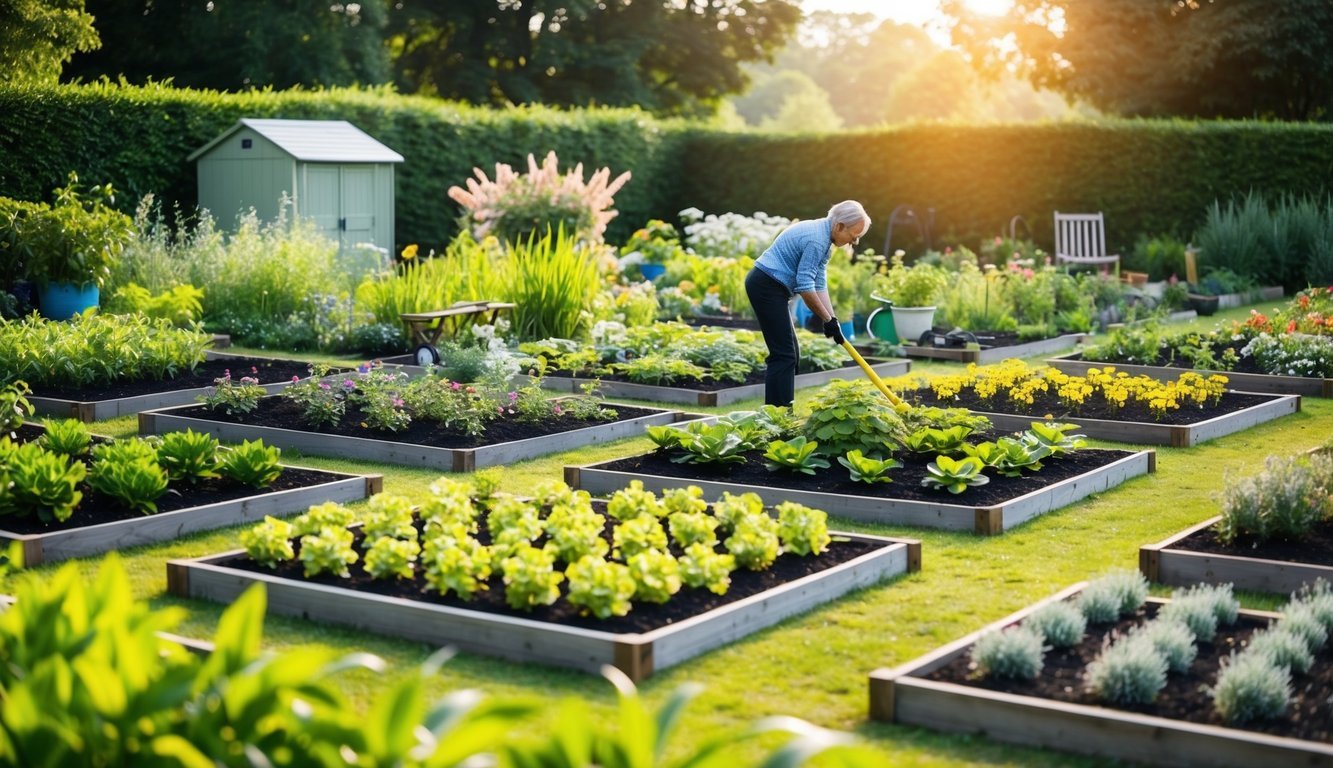
Managing pests is a key part of keeping my garden healthy.
I like to stay proactive by regularly checking my plants for any signs of trouble.
A quick look can often prevent a small issue from becoming a big problem.
If I spot pests, I don’t just wait for them to go away.
I take action right away.
Traps work well for common garden invaders like slugs and pill bugs.
Elevating my plants can also help protect my crops.
I’ve found that introducing beneficial insects, like ladybugs, can really make a difference.
They help keep pest numbers down without harmful chemicals.
Plus, they make my garden feel vibrant and alive.
For natural deterrents, I use things like dried blood meal sprinkled around.
It can deter larger pests like deer and rabbits.
Just remember, it might attract dogs, so I often cover it with garden lime.
I believe in an integrated approach, mixing various tactics to manage pests.
Staying observant and taking early action helps me enjoy a thriving garden year after year.
Understanding Your Garden Space
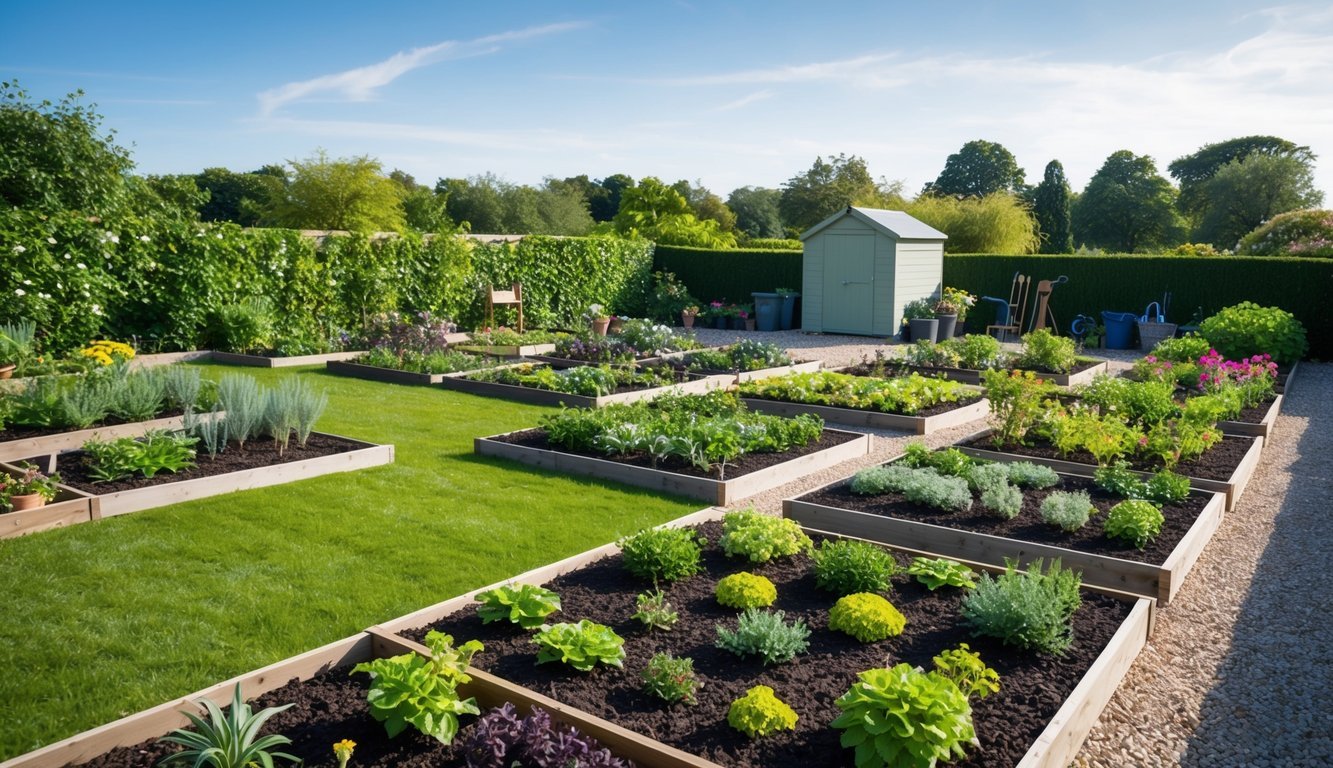
A successful garden starts with knowing your space well.
By assessing soil quality and mapping sunlight exposure, I can create a thriving environment for my plants.
Assessing Soil Quality
To determine the best conditions for my plants, I first test my soil.
Using a simple soil test kit, I can check pH levels and nutrient content.
Here’s what I focus on:
- pH Level: Most vegetables prefer a pH between 6.0 and 7.0.
- Nutrients: Look for nitrogen, phosphorus, and potassium levels to ensure that my soil is nutrient-rich.
After testing, I can amend the soil with compost or organic fertilizers as needed.
Adding 3-4 inches of compost initially helps improve soil structure and drainage.
Once my soil reaches a loamy state, I reduce the compost frequency to avoid nutrient overload.
Getting this right ensures that my plants will have a solid foundation to grow.
Mapping Sunlight Exposure
Next, I analyze sunlight exposure to find the best spots in my garden.
Sunlight is crucial for plant growth, so here’s how I approach it:
- Observe Patterns: I take note of how sunlight moves across my garden throughout the day.
- Identify Zones: I categorize areas into full sun (6+ hours), partial sun (3-6 hours), and shade (less than 3 hours).
Using this information, I can plan my layout effectively.
For instance, I place sun-loving vegetables like tomatoes and peppers in the brightest spots, while shade-tolerant plants like lettuce thrive in less direct sunlight.
Making these careful observations helps me maximize the potential of my garden space.
Efficient Watering Techniques
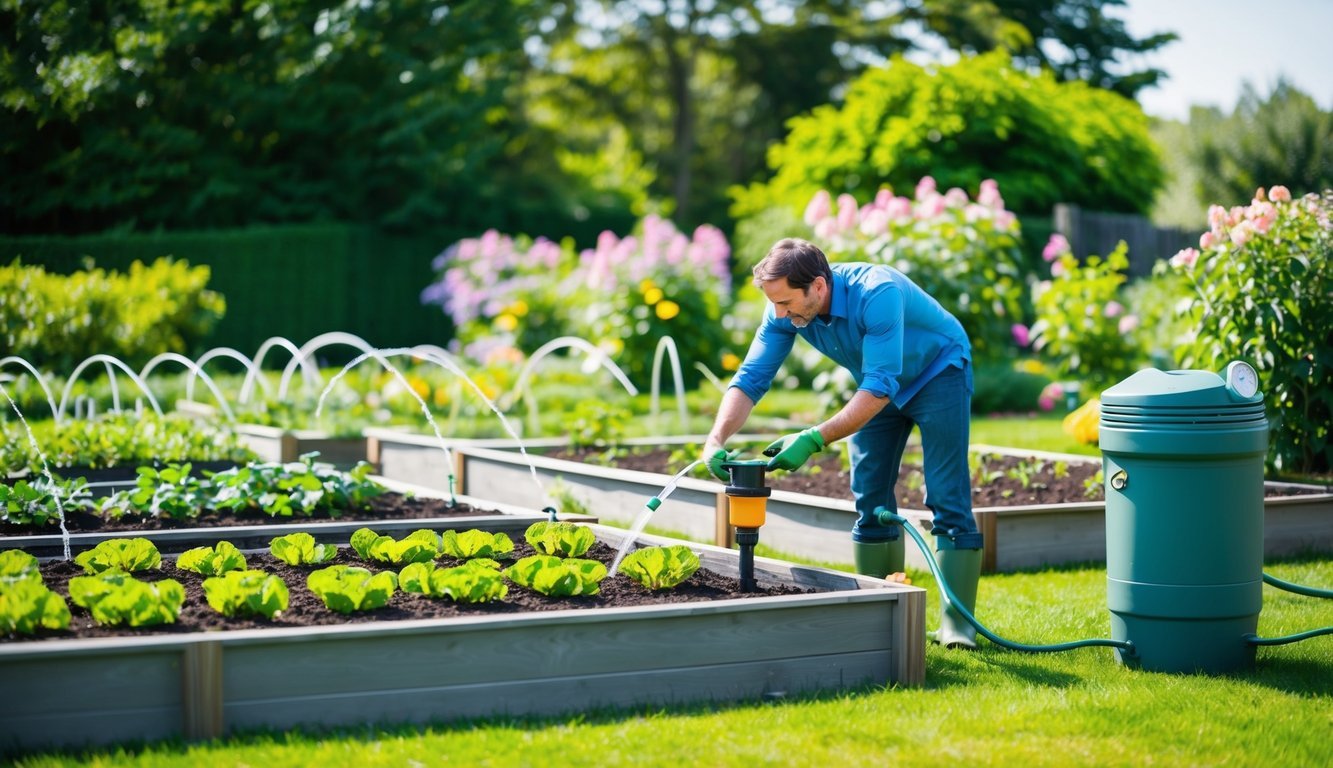
Managing a large garden means finding efficient ways to keep plants hydrated.
Selecting the right irrigation system and adopting water conservation methods can save time and resources while promoting plant health.
Choosing the Right Irrigation System
The best irrigation system for my garden depends on its size and layout.
I often consider options like drip irrigation, soaker hoses, or traditional sprinkler systems.
Drip Irrigation: This method delivers water directly to the roots, minimizing evaporation and runoff.
It’s particularly effective for vegetable gardens or flower beds.
Sprinkler Systems: These are great for larger areas.
I prefer the oscillating type for even coverage.
Soaker Hoses: They’re easy to lay out and work well in garden beds, allowing moisture to seep into the soil slowly.
I usually check the soil moisture every few days to adjust my watering schedule as needed.
Water Conservation Tips
Conserving water is essential in gardening, especially during dry seasons.
These techniques help a lot:
-
Mulching: I apply a 2- to 3-inch layer of mulch around plants. This retains soil moisture and reduces evaporation.
-
Water Timing: I water in the early morning or late afternoon to prevent evaporation.
-
Soil Moisture Monitoring: I frequently check soil moisture to determine when my plants genuinely need water. Using a moisture meter helps a lot.
-
Rain Barrels: Collecting rainwater is a simple way to reduce my water usage. I place barrels under downspouts for easy access.

